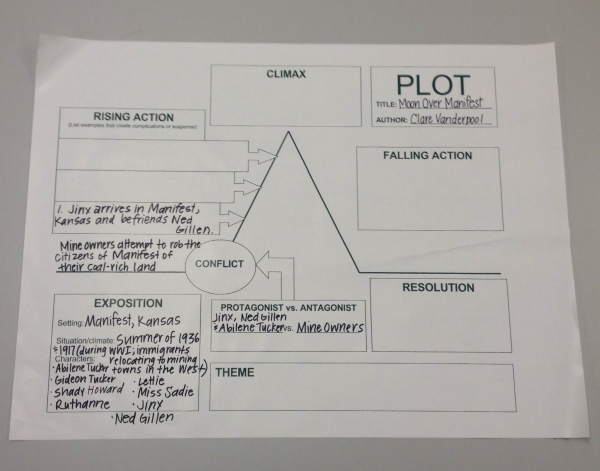By: Lindsey Graff on December 13th, 2013
Academic Subject: English Language Arts | Grade Level: Secondary (7-12) | Grade Level: Intermediate (3-6) | VariQuest Tools: Design Center Software | VariQuest Tools: Poster Maker 3600 | Featured Topics: Lessons and Activities
A plot diagram aids students in mapping out how a story’s plot unfolds in a series of episodes.
Print Five Elements of a Story (VIS454). Print one or two* poster-size copies of a plot diagram, and make a class set of 8 ½ x 11 copies. (See an example of a plot diagram here at ReadWriteThink.org: http://www.readwritethink.org/files/resources/lesson_images/lesson800/IdentifyPlot.pdf.)
*You may want to use two plot diagrams graphic organizers for Moon Over Manifest since the author tells the story through two parallel storylines.
Introduce a new genre, such as historical fiction, to students. Over the course of the genre study, read aloud an historical fiction novel, such asMoon Over Manifest, by Clare Vanderpool. Students should select historical fiction novels to read independently.
Display the Five Elements of a Story poster and read through the literary terms labeled on it: Exposition, Setting, Characters, Theme, Rising Action, Climax, Falling Action, Resolution, etc… Throughout the read aloud, pause when appropriate, and think aloud to students, modeling how to fill in the Plot Diagram graphic organizer poster. Keep the poster displayed as an anchor chart for students to refer to as they read their individual historical fiction books and complete a plot diagram independently.
Consider extending this lesson by revisiting each of the main events that unfold during the rising action, climax and falling action and identifying how the character changed as a result of each event. Write these on post-it notes and add to the poster-sized graphic organizer in the appropriate place.
